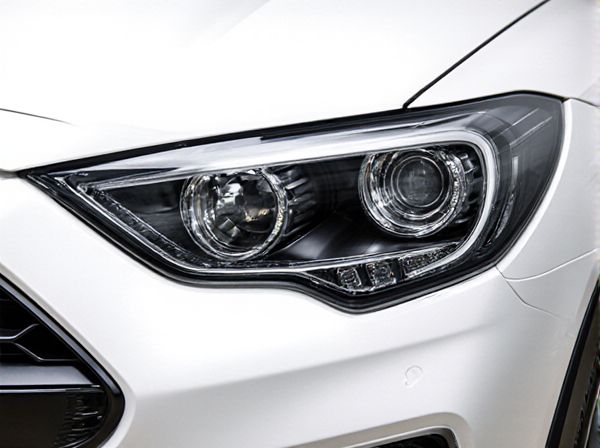
Photo illustration: Bi-xenon vs Bi-LED
Bi-xenon headlights offer brighter and more intense light with a natural color temperature, enhancing nighttime visibility and safety on the road. Bi-LED headlights, on the other hand, provide better energy efficiency and longer lifespan while delivering consistent, crisp illumination with less heat production. Your choice between the two should consider factors like light quality, energy consumption, and durability for optimal driving performance.
Table of Comparison
| Feature | Bi-Xenon Headlights | Bi-LED Headlights |
|---|---|---|
| Light Source | High-intensity xenon gas discharge bulb | Light Emitting Diode (LED) technology |
| Brightness | Up to 3,000 lumens | Up to 4,000 lumens |
| Energy Efficiency | Moderate power consumption (35W per bulb) | High energy efficiency (around 15-20W per bulb) |
| Lifespan | Approximately 2,000 - 3,000 hours | Up to 30,000+ hours |
| Heat Emission | High heat output | Low heat output |
| Cost | Moderate initial cost | Higher upfront cost |
| Light Quality | Bright white with slight bluish tint | Pure white with customizable color temperature |
| Response Time | Slower start-up time (about 2 seconds) | Instant illumination |
| Environmental Impact | Contains xenon gas; moderate | More eco-friendly; less hazardous materials |
Introduction to Bi-Xenon and Bi-LED Headlights
Bi-xenon headlights utilize xenon gas bulbs that emit bright, intense light with high color temperature, providing improved visibility and longer lifespan compared to traditional halogen bulbs. Bi-LED headlights feature advanced light-emitting diodes designed to deliver energy-efficient, crisp illumination with faster activation times and superior durability. Both lighting systems offer adaptive technology for enhanced road safety and optimized beam patterns.
How Bi-Xenon Headlights Work
Bi-xenon headlights operate using a single xenon bulb that provides both high and low beams by mechanically shifting a shutter inside the projector housing, enabling efficient light distribution without needing separate bulbs. This system produces brighter, more natural white light with higher intensity and longer reach compared to traditional halogen lamps. The precise control of beam patterns in bi-xenon headlights enhances nighttime visibility and reduces glare for oncoming drivers.
How Bi-LED Headlights Function
Bi-LED headlights operate by utilizing light-emitting diodes (LEDs) as the primary light source, producing a brighter, whiter light compared to traditional Bi-xenon headlights. These systems use separate LED modules or an adjustable lens to switch between low and high beam functions efficiently, offering precise light distribution and instant illumination. Bi-LED technology improves energy efficiency, longevity, and reduces maintenance costs compared to Bi-xenon bulbs that rely on gas discharge for light production.
Brightness and Light Output Comparison
Bi-xenon headlights produce a brighter and more intense light output compared to Bi-LED systems, offering superior visibility on the road. Bi-xenon lamps typically emit around 3,000 lumens per bulb, while Bi-LEDs generate approximately 2,500 lumens, resulting in a noticeable difference in brightness. However, Bi-LEDs provide a more consistent and energy-efficient light output with better color temperature control, enhancing overall driving experience despite slightly lower luminosity.
Energy Efficiency: Bi-Xenon vs Bi-LED
Bi-LED headlights consume significantly less energy compared to Bi-Xenon lights, improving vehicle fuel efficiency and reducing electrical load. Bi-LED technology offers enhanced luminous efficacy, converting more electrical power into visible light, which maximizes energy savings. Bi-Xenon lamps, while brighter than traditional halogens, require higher power consumption and generate more heat, resulting in lower energy efficiency than Bi-LED systems.
Lifespan and Durability Differences
Bi-xenon headlights typically have a lifespan of around 2,000 to 3,000 hours, whereas Bi-LED headlights can last up to 30,000 hours or more, making LEDs significantly more durable. Bi-LED units resist shock and vibration better due to solid-state construction, while Bi-xenon systems contain fragile xenon bulbs and ballasts prone to wear. This extended lifespan and enhanced durability of Bi-LEDs result in lower maintenance costs and greater reliability over time.
Installation and Compatibility Considerations
Bi-xenon headlights typically require a more complex installation process due to the need for ballasts, high-voltage wiring, and precise projector alignment, which often makes them less compatible with older vehicle electrical systems. Bi-LED headlights offer easier installation with lower power requirements and plug-and-play options that increase compatibility across a wider range of modern vehicles. Considering vehicle-specific wiring harness compatibility and existing headlight housing is essential for both Bi-xenon and Bi-LED upgrades to ensure optimal performance and safety compliance.
Cost Comparison: Initial and Long-term
Bi-xenon headlights typically have a lower initial cost compared to Bi-LED systems due to simpler technology and widespread availability. However, Bi-LED lights offer improved energy efficiency and longer lifespan, resulting in reduced maintenance and replacement expenses over time. The long-term cost savings of Bi-LEDs often offset their higher upfront investment, making them more economical in the overall ownership cycle.
Safety and Performance in Real Driving Conditions
Bi-xenon headlights provide brighter and more intense light output than traditional halogen bulbs, improving visibility and safety during nighttime driving and adverse weather conditions. Bi-LED systems offer superior energy efficiency, longer lifespan, and faster response times, enhancing overall driving performance and reducing maintenance needs. Real driving tests show Bi-LED technology delivers more consistent illumination with better beam pattern control, reducing glare for oncoming traffic and increasing driver comfort and safety.
Which Headlight Technology is Best for You?
Bi-xenon headlights deliver intense, bright white light with excellent range and color accuracy, making them ideal for clear long-distance visibility. Bi-LED headlights offer superior energy efficiency, longer lifespan, and quicker illumination, enhancing safety and reducing maintenance costs. Choosing the best technology depends on whether you prioritize brightness and range (Bi-xenon) or efficiency and durability (Bi-LED).
 caratoz.com
caratoz.com